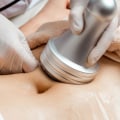Do you suffer from unsightly varicose veins or spider veins? You're not alone. Many people, especially women, are looking for ways to treat their vein problems and improve the look of their legs. Fortunately, there are many treatments available today that can help reduce the appearance of varicose and spider veins. In this article, we'll explore everything you need to know about vein treatments and how they can help you achieve smooth, healthy-looking legs. Vein treatments are minimally invasive procedures that can effectively reduce the appearance of varicose and spider veins.
These treatments can be used to improve the overall look of your legs, boost circulation, reduce pain and discomfort, and even prevent future vein problems from occurring. From sclerotherapy to laser therapy, there are a variety of treatment options available to meet your individual needs. So if you're looking for a way to improve the appearance of your veins and get back to feeling confident about your legs, keep reading to learn more about the different types of vein treatments available. Vein treatments are a type of medical procedure used to treat varicose and spider veins. The goal of these treatments is to reduce or eliminate the appearance of these veins, improving the look of your legs and restoring your confidence. There are various types of vein treatments available, including sclerotherapy, laser therapy, and endovenous ablation.
All of these treatments have their own advantages and disadvantages, and it is important to consider all aspects before making a decision.
Sclerotherapy
is one of the oldest forms of vein treatments. It involves injecting a solution directly into the affected veins, causing them to collapse and eventually disappear. The treatment is typically done in a doctor’s office, and results can be seen within four to six weeks. Common side effects include bruising, swelling, and itching.It is also important to note that multiple treatments may be needed in order to achieve desired results.
Laser therapy
is another type of vein treatment. This procedure uses an intense beam of light to target and damage the veins. Laser therapy is often done in a doctor’s office, and results can be seen within a few weeks. Common side effects include bruising, swelling, itching, and redness.In some cases, multiple treatments may be necessary.
Endovenous ablation
is a relatively new form of vein treatment. It involves using radiofrequency or laser energy to heat the affected veins, causing them to collapse and eventually disappear. The procedure is usually done in a doctor’s office, and results can be seen within four to six weeks. In some cases, multiple treatments may be necessary. When considering any type of vein treatment, it’s important to understand the pros and cons of each option.Before-and-after images can provide an idea of what kind of results can be expected with a particular treatment. It is also important to consider the recovery time associated with each procedure. Additionally, it’s important to discuss any potential risks or side effects with your doctor before making a decision. Choosing the right vein treatment for a particular case depends on several factors, including the size and location of the affected veins, as well as the patient’s overall health. Your doctor will be able to provide advice on which option is best for you based on your individual needs. Preparing for any type of vein treatment involves scheduling a consultation with a doctor and getting medical clearance from your primary care physician.
It is also important to discuss any lifestyle changes that may be necessary before and after the procedure, such as reducing physical activity or avoiding direct sun exposure in the weeks following the procedure. Potential risks associated with vein treatments include bleeding, infection, scarring, pain, and nerve damage. It is important to discuss these risks with your doctor before undergoing any type of procedure. Additionally, there are several steps you can take to reduce any potential risks associated with vein treatments, such as avoiding strenuous activities for several days afterwards and keeping the treated area clean and dry. Post-treatment care is an important part of any vein treatment procedure. This includes wound care and following up with your doctor for check-ups.
Additionally, it is important to follow any lifestyle recommendations provided by your doctor in order to ensure optimal results. The cost of vein treatments varies depending on the type of procedure chosen and the number of treatments necessary for optimal results. Many insurance plans cover at least part of the cost for certain types of treatments. Additionally, many medical spas offer payment plans or other financing options.
Potential Risks
It is important to be aware that all medical treatments, including vein treatments, involve potential risks. Generally, the risks associated with vein treatments are minor and can include mild bruising, bleeding, or swelling near the treated area.In some rare cases, more serious side effects can occur. These can include skin discoloration, infection, and nerve damage. To minimize the potential risks of vein treatments, it is important to consult a qualified health professional and to ensure that the clinic or medical facility you choose adheres to strict safety protocols. Additionally, make sure to discuss any existing medical conditions with your doctor prior to treatment.
Costs and Payment Options
The cost of vein treatments varies depending on the type of procedure being performed and the severity of the condition.In general, sclerotherapy is the least expensive option, followed by endovenous laser therapy (EVLT) and ambulatory phlebectomy. Some insurance companies may cover a portion of the cost, so it is important to check with your provider before undergoing any treatment. If your insurance does not cover your treatment, there are several payment options available. For those paying out of pocket, many providers offer payment plans that allow you to spread out your costs over a certain period of time. Credit cards may also be accepted, as some providers offer a 5-10% discount for cash or credit card payments.
Additionally, some providers offer financing through Care Credit or other third-party lenders. It is important to note that the costs associated with vein treatments are not usually covered by Medicare or other government-funded healthcare programs. However, some providers may offer discounts for patients who are unable to afford the full cost of treatment. Be sure to speak with your provider about any potential discounts or payment plans that may be available.
Preparation for Treatment
Before undergoing any vein treatments, it’s essential to schedule a consultation with a doctor. During the consultation, the doctor will ask about your medical history and perform a physical examination.They may also order additional tests to determine the severity of your condition and identify the best treatment option. It’s important to be honest about your medical history and share any relevant information that may help the doctor make an accurate diagnosis. In some cases, you may need to get medical clearance from your primary care physician or cardiologist prior to treatment. This is especially important if you have any preexisting medical conditions, such as heart or kidney disease, or if you take any medications that could interact with the treatment. Before scheduling an appointment, it’s also a good idea to research the different types of vein treatments available and ask your doctor questions about their experience performing the procedure. This will help ensure that you get the best possible outcome and reduce the risk of complications.
Types of Vein Treatments
Vein treatments are a range of therapies used to reduce or eliminate visible varicose and spider veins, improving the appearance of your legs and restoring your confidence.There are three main types of vein treatments available: sclerotherapy, laser therapy, and endovenous ablation. Each treatment works in a different way and has its own potential risks and side effects.
Sclerotherapy
Sclerotherapy is an injection-based procedure that involves injecting a solution into the affected vein. This solution causes the vein to shrink and eventually disappear.Common side effects of sclerotherapy include itching, redness, and swelling. Most patients can return to their normal activities within a few days.
Laser Therapy
Laser therapy uses lasers to target and close off affected veins. A specialized device is used to direct laser energy onto the affected veins, causing them to collapse and be absorbed into the body.Common side effects of laser therapy include swelling, bruising, and discomfort.
Endovenous Ablation
Endovenous ablation is a minimally invasive procedure that uses radiofrequency energy or heat to target and close off affected veins. This procedure is more invasive than sclerotherapy or laser therapy and requires a longer recovery time. Common side effects of endovenous ablation include swelling, bruising, and discomfort.Most patients can return to their normal activities within two weeks.
Post-Treatment Care
Post-treatment care is an important part of the vein treatment process and can help ensure that the results are long-lasting. It's important to follow your doctor’s instructions for wound care and to attend any follow-up visits. After the treatment, you may need to wear compression stockings for a few weeks to help reduce swelling and speed up healing. Your doctor will likely advise you to avoid strenuous activity for a few days after the procedure.Your doctor may also recommend that you take it easy and avoid extended periods of standing or sitting. Additionally, it's important to practice good hygiene and keep your legs clean and dry. In some cases, you may need multiple treatments to achieve the desired results. Your doctor will be able to advise you on how many treatments you need.
It's also important to attend all follow-up visits with your doctor, as they will be able to track your progress and determine if additional treatments are necessary.
Wound Care
It's important to take good care of the treated area after your procedure. This includes keeping the area clean and dry, avoiding tight clothing and activities that could cause skin irritation, and avoiding any direct sunlight on the treated area. You should also avoid using hot tubs or swimming pools until your doctor gives you clearance.Follow-Up Visits
Your doctor may recommend that you attend follow-up visits for several months following your treatment.During these visits, your doctor will be able to monitor the progress of your treatment and make adjustments if needed. These follow-up visits are also an opportunity for your doctor to answer any questions or concerns you may have about your treatment or the healing process.
Choosing the Right Treatment
Vein Treatments: Choosing the Right TreatmentDeciding on the right vein treatment for a particular case requires understanding the various types of treatments available, as well as taking into account factors such as the location of the veins, severity of symptoms, and personal preferences. The type of vein treatment you should choose will depend on several factors. One factor is the size, location, and number of veins that need to be treated.For example, if you have large varicose veins in your legs, you may need to undergo a surgical procedure to remove them. If you have smaller spider veins, laser therapy or sclerotherapy may be a better option. Other factors to consider include the severity of your symptoms, your lifestyle and personal preferences, and any underlying medical conditions that may affect your treatment. Your doctor can help you decide which type of vein treatment is best for you.
They will assess your condition and recommend a treatment plan based on your individual needs. It’s important to discuss all available options with your doctor so that you can make an informed decision about which vein treatment is right for you. In addition to discussing the different types of treatments with your doctor, it’s also important to ask questions about potential risks and benefits associated with each type of treatment. This will help you make an informed decision about which type of treatment is best for you.
Finally, it’s important to keep in mind that vein treatments can be expensive and time consuming. Therefore, it’s important to weigh all of your options carefully before making a decision. Vein treatments can be a great way to reduce or eliminate the appearance of varicose and spider veins. There are several types of treatments available, and it’s important to research and understand the potential risks before choosing a treatment.
Preparation for treatment and post-treatment care are also essential for optimal results. Costs and payment options vary depending on the type of treatment chosen. If you’re considering vein treatment, it’s important to talk to your doctor about your options. They can help you decide which type of treatment is best for you. Additionally, there are many resources available online for further reading, such as the National Institute of Health and the American Vein and Lymphatic Society.


